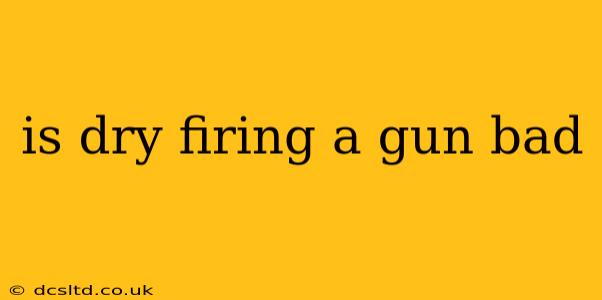Dry firing, the act of pulling the trigger on an unloaded firearm, is a topic frequently debated among gun owners. While seemingly innocuous, the potential consequences of dry firing depend heavily on the type of firearm and the precautions taken. Let's delve into the details to understand when it's safe and when it's detrimental to your weapon.
What Happens When You Dry Fire a Gun?
When you dry fire a gun, the firing pin strikes the breech face or the primer pocket (depending on the firearm's design). This impact can cause wear and tear over time. The severity of this damage depends on several factors:
- Type of Firearm: Some firearms are specifically designed to withstand dry firing without damage, while others are more susceptible to damage. Modern firearms typically have stronger firing pins and breech faces, but older or cheaper models may be more vulnerable.
- Firing Pin Material: Harder firing pins are less prone to damage, but they can also cause more wear on the breech face.
- Frequency of Dry Firing: Regular, extensive dry firing will naturally increase wear and tear, even in firearms designed to handle it.
Is Dry Firing Bad for My Gun? (The Answer is Nuance)
The short answer is: it can be, but it doesn't have to be. With the right precautions, dry firing can be a safe and beneficial practice. However, neglecting these precautions can lead to damage.
Can Dry Firing Damage My Gun?
Yes, dry firing can damage your gun, particularly:
- The firing pin: Repeated impacts can cause the firing pin to break or become deformed.
- The breech face: The area where the firing pin strikes can become dented or pitted over time. This can affect the accuracy and reliability of the firearm.
- The receiver: In some cases, the force of the firing pin can damage the receiver itself.
What Types of Guns Should Never Be Dry Fired?
Certain firearms should absolutely never be dry fired without a snap cap or similar device:
- Older firearms: These are often more delicate and susceptible to damage from dry firing.
- Firearms with delicate firing pins: Some guns use softer metals for their firing pins that are more easily damaged.
- Rimfire firearms: These are generally more prone to damage from dry firing, as the firing pin often strikes a softer area.
How Can I Safely Dry Fire a Gun?
Here's how to minimize the risks:
- Use snap caps: Snap caps are inert cartridges that mimic the dimensions and feel of live ammunition, protecting the firing pin and breech face from impact damage. This is the best and most recommended method for safe dry firing.
- Understand your firearm: Read your firearm's manual carefully. It will often state whether dry firing is safe and under what conditions.
- Use proper technique: Make sure you're maintaining a consistent grip and trigger pull during dry firing.
- Limit the frequency: Avoid excessive dry firing. Practice only as much as needed.
People Also Ask:
What is the best way to dry fire a gun safely?
The best way to dry fire a gun safely is to use snap caps. These protect your firearm's components from damage caused by the firing pin's impact. Always consult your firearm's manual for specific recommendations.
Does dry firing damage a Glock?
Glocks are generally considered relatively durable and can withstand dry firing, although using snap caps is still the best practice for minimizing wear and tear.
Can you dry fire a revolver?
Revolvers can be dry fired, but using snap caps is always recommended to prevent damage to the firing pin and cylinder.
Why shouldn't you dry fire a rifle?
While some rifles can tolerate dry firing, the risk of damage to the firing pin and breech face is always present. Using snap caps is crucial to prevent unnecessary wear and tear, regardless of the rifle type.
Is dry firing a pistol harmful?
Dry firing a pistol can be harmful if not done with the proper precautions. Using snap caps greatly mitigates the risk of damage, especially to the firing pin and the breech face.
Conclusion:
Dry firing can be a valuable tool for practicing your shooting skills, but it's essential to understand the potential risks and take the necessary precautions. Using snap caps is always the best method to safeguard your firearm and ensure its longevity. Always refer to your firearm's manual and seek advice from experienced shooters if you're unsure about anything. Remember, safe gun handling practices are paramount.
